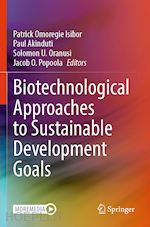
Questo prodotto usufruisce delle SPEDIZIONI GRATIS
selezionando l'opzione Corriere Veloce in fase di ordine.
Pagabile anche con Carta della cultura giovani e del merito, 18App Bonus Cultura e Carta del Docente
Biotechnological Approaches to Sustainable Development Goals presents selected contributions from the 2022 International Biotechnology Conference Exhibition and Workshop (IBCEW) that cover techniques, current trends, and cutting-edge biotechnological tools for achieving sustainable development goals (SDGs). The authors explore recent advances that solve challenges related to sustainable agriculture, climate change, prevention and control of pandemics, biotechnology for a sustainable economy, and biotechnological industries and SDGs. The IBCEW aims to share knowledge, experiences, and ideas among scientists, academics, students, industry representatives, and other professionals interested in biotechnology and attaining SDGs for development in Nigeria, Africa, and globally.
Dr. Patrick Omoregie Isibor is currently a Lecturer in the Department of Biological Sciences at Covenant University. He received his Ph.D. and M.Sc. in Environmental Quality Management from the University of Benin and a B.Sc. in Zoology from Ambrose Alli University. Dr. Isibor’s research interests include ecotoxicology, hydrobiology, bioaccumulation, biosequestration, biodiversity conservation, and aquatic ecology. He is a member of the Association for Environmental Impact Assessment of Nigeria (AEIAN), the International Association of Risk and Compliance Professionals (IARCP), and the African Society for Toxicological Sciences (ASTS). He is an Editor for the African Journal of Health, Safety, and Environment and a reviewer for several reputable international journals.
Dr. Paul Akinduti is a Lecturer and researcher with the Microbiology Unit of the Department of Biological Sciences at Covenant University. He received his Ph.D. in Medical Microbiology and Bacteriologyfrom Olabisi Onabanjo University. He is a Fellow of the Medical Laboratory Science Council of Nigeria and a recipient of the World Academy of Sciences and Bill and Melinda Gates Foundation Travel Awards. Dr. Akinduti’s areas of research interest include antimicrobial agents, antimicrobial resistance, molecular biology, bacterial pathogenesis, antimicrobial susceptibility testing, bacterial antibiotic resistance, bacteriology, antibacterial activity, bacterial drug resistance, diagnostic microbiology, molecular bacteriology, molecular microbiology, foodborne diseases, molecular typing, microbial genetics, bacterial toxins, bacterial conjugation, and pathogenesis.
Prof. Solomon Oranusi is a Professor of Microbiology at Covenant University, where he has also served as Sub-Dean of the School of Postgraduate Studies. Prof. Solomon holds a B.Sc degree in microbiology from the University of Nigeria Nsukka (UNN) and an M. Sc and Ph.D. in microbiology from Ahmadu Bello University (ABU) Zaria. He is a Fellow of the Institute of Medical Laboratory Science Council of Nigeria and a Public Analyst with MIPAN. His research interests include biogas and digestate bio-fertilizer production from food and agricultural wastes (waste-to-wealth), food safety, HACCP, and public and environmental health. Professor Oranusi is a member of several academic and professional organizations, including the Institute of Public Analysts of Nigeria (IPAN), the Association of Industrial Microbiologists of Nigeria (AIMN), the Nigerian Institute of Food Science and Technology (NIFST), the Institute of Medical Laboratory Sciences of Nigeria (IMLSN), and the American Society for Microbiology (ASM). He has published more than 130 peer-reviewed scientific articles and is a reviewer for several international journals. He has served as an examiner for postgraduate theses and dissertations and as an assessor for the promotion of applicants to the professorial cadre of academic institutions.
Dr. Jacob Popoola is an Associate Professor of Pure and Applied Biology at Bowen University. He was previously a researcher and Senior Lecturer in the Department of Biological Sciences at Covenant University, where he conducted research in applied ethnobotany, plant genetics, and molecular biology. Dr. Popoola received his Ph.D. in Biology (Plant Genetics and Biotechnology) from Covenant University. His current projects include sequencing diversity of moringa oleifera towards genetic improvement, biosystematic studies of miscellaneous neglected underutilized legumes as future food security, and characterization of root and tubers for utilization.











Il sito utilizza cookie ed altri strumenti di tracciamento che raccolgono informazioni dal dispositivo dell’utente. Oltre ai cookie tecnici ed analitici aggregati, strettamente necessari per il funzionamento di questo sito web, previo consenso dell’utente possono essere installati cookie di profilazione e marketing e cookie dei social media. Cliccando su “Accetto tutti i cookie” saranno attivate tutte le categorie di cookie. Per accettare solo deterninate categorie di cookie, cliccare invece su “Impostazioni cookie”. Chiudendo il banner o continuando a navigare saranno installati solo cookie tecnici. Per maggiori dettagli, consultare la Cookie Policy.